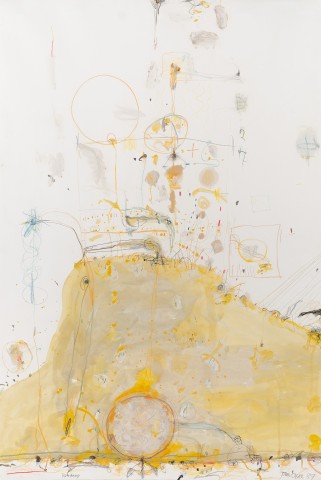ROOKERY, 1989
JOHN OLSEN
watercolour, gouache, pastel and pencil on paper
152.0 x 102.0 cm
signed and dated lower right: John Olsen 89
inscribed with title lower left: ROOKERY
Australian Galleries, Melbourne (labels attached verso)
Private collection, New South Wales, acquired from the above 5 April 1990
Olsen, Greenhill Galleries, Perth, 24 October – 9 November 1989, cat. 2
John Olsen, Australian Galleries, Sydney, 2 – 28 April 1990, cat. 13
John Olsen – Bank of America Merrill Lynch, Bank of America, Sydney, 13 January – 30 April 2019
Summer Group Show, OLSEN Gallery, Sydney, 16 December 2020 – 16 January 2021
Amphibia: The Anisimoff Collection, OLSEN Gallery, Sydney, 23 June –10 July 2021
Olsen J., and McGregor, K., John Olsen: Drawing – The Human Touch, Macmillan Art Publishing, Melbourne, Australia, 2014, p. 160 (illus., dated as 1990)
Upon the invitation of film-makers Ken Duncan and Robert Raymond, and esteemed naturalist Vince Serventy, John Olsen first ventured to the Australian interior in the early 1970s to participate in the ‘Wild Australia’ film series commissioned by the Australian Broadcasting Commission. Immediately awestruck by the incredible diversity of the various ecosystems he encountered during the journey, Olsen thus began his enduring fascination with observing and painting the teeming life of wetlands, estuaries and lily ponds – stimulated not only by individual species, but a sense of the whole, seething mass, ‘a carnival of life’. Indeed, the artist’s sheer wonderment at the miracle of mother nature and her life-affirming properties is especially palpable in his reflections upon travelling to Lake Eyre in 1974 where he witnessed the arid, salt-encrusted plains of the South Australian desert erupting into life following the extraordinary floods of 1973 (only the second such occurrence since white settlement); ‘…I draw studies of insects, animals and birds that will eventually be realised as prints and watercolours. My devotion to Chinese art and philosophy finds a fulfilment in this experience. Nothing too small or too strange should escape my attention – an insect’s wing, the leap of a frog, the flight pattern of dragonflies. They all induce poetic rapture’.1
Over the subsequent two decades, Olsen would continue this devotion to the Australian outback with repeated visits to Lake Eyre and North Queensland providing the impetus for some of his most lyrical insights into the natural environment. A particularly charming example of Olsen’s meditations upon his travels to the interior, Rookery, 1989 derives from a blissful period in Olsen’s life, painted the year he married his fourth wife, Katharine Howard, who ran a guesthouse in Wentworth Falls in the Blue Mountains at the time. With its pulsating calligraphic line denoting the busy flight paths of the teeming birdlife and highly tilted plane that may be viewed on both a macro and micro level, the composition resonates with a vitalistic energy – betraying a sense of not only keen observation, but joyful celebration derived from the artist’s spiritual immersion in the landscape as well. For Olsen indeed, the wild reaches of the Australian outback offered more than mere external phenomena to be accurately recorded. More fundamentally perhaps, the experience became the catalyst for a myriad of ideas and metaphorical connections that would permeate Olsen’s art for decades to come, reaffirming his Taoist belief in the total interconnectedness of all living forms and thus, heralding a new spirituality in his art. As Olsen himself poignantly muses,
‘…The enigma of it all. It is a desert and it can be full. After the rains, it is so incredibly abundant; so what you are looking at in one place, as if through an act of the Dao, becomes full… It has an effect on you when you are there because all the time it is impossible for you to accept fully the sense of impermanence and transitoriness. Somehow it affects you - you realise that you are looking at an illusion really. I don't think that there is anything more Buddhist than that.’2
1. The artist quoted in Olsen, J., Drawn from Life, Duffy and Snellgrove, Sydney, 1997, p. 116
2. The artist quoted in Hart, D., John Olsen, Craftsman House, Sydney, 1991, p. 135
VERONICA ANGELATOS
